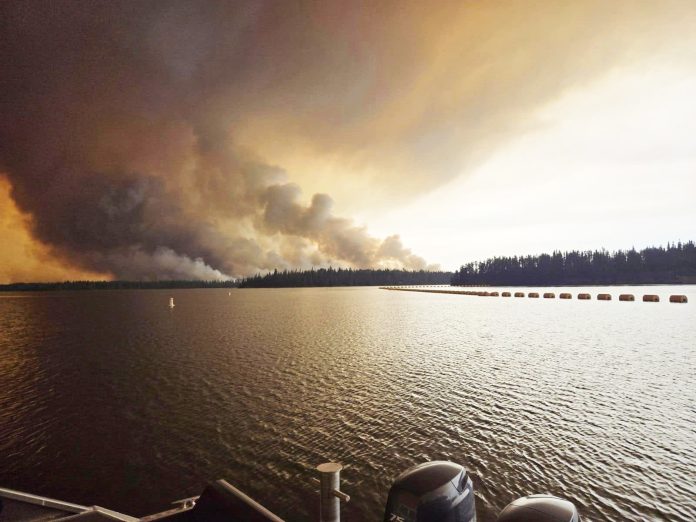
While the Flanagan Fire has moved closer to Sandy Bay and grown in size, 109 families have remained in the community in a sheltered environment.
There are also 218 essential workers remaining, who are looking after those who remain as well as providing other essential tasks, according to Duane Hiebert, Peter Ballantyne Cree Nation (PBCN) emergency management director. Hiebert said people still in the community and evacuees are hoping for rain, but there are thunderstorms potentially in the forecast.
“(We’re) hoping it brings some additional rain,” he said. “They haven’t had rain for a while. They had a downpour the other day. Somebody saw three drops of rain.”
Although, thunderstorm can lead to additional fires, any rain could potentially help the situation, Hiebert said.
According to satellite imagery the fire has grown to 28,045 ha from 19,310 ha, but, Hiebert said, it was “really difficult to tell” because of the smoky conditions.
The Saskatchewan Public Safety Agency (SBSA) has increased the number of firefighters working on the fire, which “is good,” Hiebert said.
Those remaining in the community are in a “sheltering place and “they’re not to go in and out … we’re providing food hampers for those individuals,” Hiebert added.
Essential workers remaining in the community are providing security, doing fire patrols around the community and some fuel removal.
“Removing brush away from the homes” is one of the tasks, cooking food for those families staying in the community are also party of their work.
Should the situation get too volatile for people to remain, they have transportation units in the community. “We have a couple of school buses and private vehicles,” but, “the community itself is quite well protected. We have sprinkler systems set up around all infrastructure, the critical infrastructure, the community band office and water treatment plant, the Village Office, the schools, as well as a fire break that has been re cleaned and rejuvenated by Public Safety bringing in dozers or cats so they’ve taken that down to mineral soil. We do have a big irrigation values protection sprinkler system set up around the fire break and it’s turning the community into mud. So, it must be fairly powerful, putting a lot of water in the community,” Hiebert said.
The Emergency Operations Centre (EOC), set up in July, is also active. Meetings are held daily, and reports are given virtually by SPSA and people are kept informed.
“There’s a lot going on to keep them safe,” he said of the people in the community.
Evacuees in Saskatoon, staying at the Saskatoon Inn, have had to be moved for two days to Prince Albert due to a pre-evacuation commitment the hotel had. Three Hundred and Nine (309) evacuees were moved and are slated to return to Saskatoon on Thursday.
In the Arm fire, a significant burn out was done three days ago and one area of the fire, closest to the community burned itself out. The active part of that fire is now 14 kms from the community and 11 kms from Highway 911, the only access road into the community of Deschambault Lake.
There are still evacuees from the community in Prince Albert. They are people, 120, from Deschambault Lake on the chronic care list.
“We also have a number of individuals with compromised health from the community of Pelican Narrows that are also being housed in the city of Prince Albert. It’s only three or four families, it’s not a huge number,” Hiebert said.
Southend remains the “smokiest community, which is predicted for the next few days,” he said.
No one is evacuated from the community. “We’ve got clean air shelters set up and they’re hunkering down withstanding the smoke as best they can,” Hiebert said.
Sandy Bay remains the most volatile situation.
“The fire is close enough to be very concerning.”

